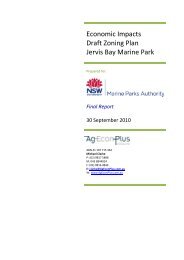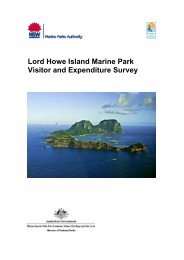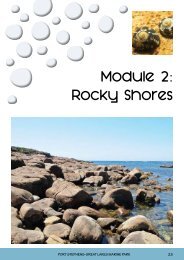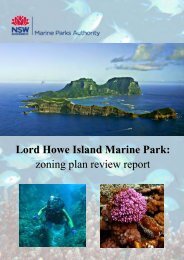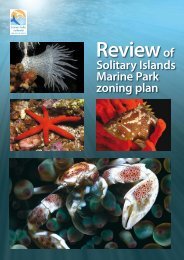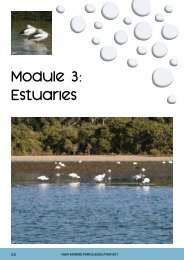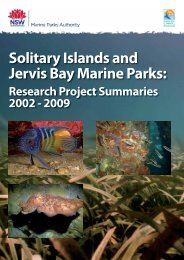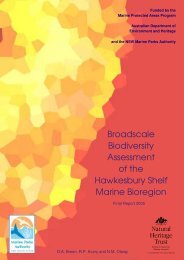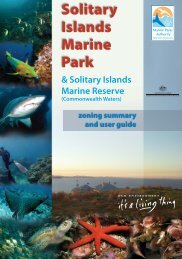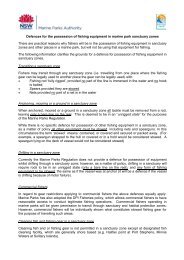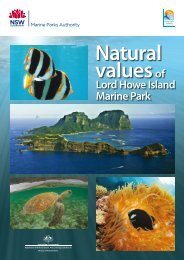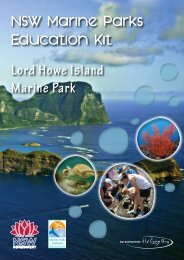Natural values of the Solitary Islands Marine Park - Marine Parks ...
Natural values of the Solitary Islands Marine Park - Marine Parks ...
Natural values of the Solitary Islands Marine Park - Marine Parks ...
- No tags were found...
Create successful ePaper yourself
Turn your PDF publications into a flip-book with our unique Google optimized e-Paper software.
30 <strong>Natural</strong> <strong>values</strong> <strong>of</strong> <strong>the</strong> <strong>Solitary</strong> <strong>Islands</strong> <strong>Marine</strong> <strong>Park</strong>Figure 42.Saltmarsh with Juncus andsalt-couch.Figure 43.Saltmarsh vegetationdestroyed by 4WD activityon Arrawarra Creek.Mangroves can contribute significantly to <strong>the</strong>productivity <strong>of</strong> estuaries through nutrient cyclingand <strong>the</strong> trapping <strong>of</strong> sediments and detritus.They provide habitat for many fish, birds andinvertebrates (Bell et al 1984, Hutchings and Saenger1987, Chapman and Underwood 1995). The mostvisible species in temperate mangrove forestsare <strong>the</strong> larger snails and crabs, including <strong>the</strong> mudperiwinkle (Littoraria luteola), mudwhelk (Bembiciumauratum) and semaphore crab (Heloecius sp.).In <strong>the</strong> marine park, mangroves are found in allestuaries (Figs. 13 and 40). A transition from asubtropical to a temperate mangrove communityoccurs in <strong>the</strong> marine park from north to south. All seven species <strong>of</strong> mangroverecorded in NSW (when mangrove fern Acrostichum speciosum and Hibiscus tiliaceusare included) have been found in <strong>the</strong> Sandon River (Figure 40b) and Wooli Wooli River(Figure 40c), <strong>the</strong> two nor<strong>the</strong>rnmost estuaries <strong>of</strong> <strong>the</strong> marine park (Taffs 2006).Only two species <strong>of</strong> mangrove are found in C<strong>of</strong>fs Creek, <strong>the</strong> most sou<strong>the</strong>rly <strong>of</strong> <strong>the</strong>marine park estuaries. This temperate Avicennia/Aegiceras community extends fromC<strong>of</strong>fs Creek to sou<strong>the</strong>rn NSW. The subtropical community includes five mangrovespecies that are at, or are close to, <strong>the</strong> sou<strong>the</strong>rnmost latitudinal limits <strong>of</strong> <strong>the</strong>irdistribution. Such species include stilted mangrove Rhizophora stylosa and large leafedorange mangrove Bruguiera gymnorhiza (Taffs 2006).There is variation in mangrove distribution and density within estuaries as well asbetween <strong>the</strong>m. For example, Station Creek, <strong>the</strong> largest ICOLL in <strong>the</strong> marine park with asystem strongly influenced by freshwater, has a very sparse occurrence <strong>of</strong> mangroves,restricted mainly to a lower–mid section. Three mangroves species have beenrecorded here: grey mangrove, mangrove fern, Hibiscus tiliaceus, and milky mangroveExoecaria agallocha (Taffs 2006). In Sandon and Wooli Wooli rivers, red mangroveRhizophora stylosa is more common in midstream to upstream sections, and is a majorcomponent <strong>of</strong> <strong>the</strong> mangrove community, despite being at <strong>the</strong> extreme sou<strong>the</strong>rn end<strong>of</strong> its range. Fur<strong>the</strong>r north in NSW it is only sparsely represented. The Corindi River waspreviously recorded as <strong>the</strong> sou<strong>the</strong>rnmost limit <strong>of</strong> a Rhizophora stylosa community inAustralia, but this species is now established in Moonee Creek.5.3 SaltmarshSaltmarsh is a habitat found in <strong>the</strong> upper intertidal area <strong>of</strong> shorelines dominatedby s<strong>of</strong>t sediment in estuaries and bays. Most saltmarsh habitat contains a diverserange <strong>of</strong> grasses, saltbushes, rushes and sedges,although <strong>of</strong>ten a small number <strong>of</strong> species dominatea particular site. There is <strong>of</strong>ten distinct zonation<strong>of</strong> species across <strong>the</strong> habitat. The lowest zone inNSW is occupied almost exclusively by samphireSarcocornia quinqueflora, with salt-couch Sporobolusvirginicus covering large areas fur<strong>the</strong>r up <strong>the</strong> shore(Morrisey 1995). However, <strong>the</strong> habitat can also haveconsiderable small-scale patchiness, with zones<strong>of</strong>ten consisting <strong>of</strong> a mosaic <strong>of</strong> species (Figure 42).



